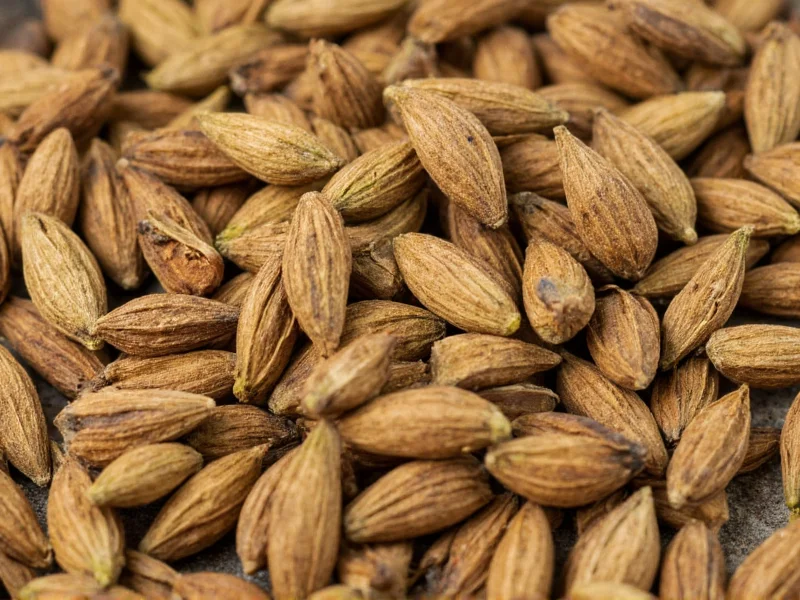Understanding what cardamom spice tastes like requires exploring its multi-dimensional flavor profile. This ancient spice, harvested from the seeds of plants in the ginger family, offers a sophisticated taste experience that has made it prized in kitchens worldwide for centuries. When you crush a cardamom pod between your fingers, the first sensation is a bright citrus aroma, followed by herbal notes reminiscent of eucalyptus and camphor, then subtle floral hints, and finally a warm, slightly spicy finish.
The Distinctive Flavor Components of Cardamom
Cardamom's unique taste comes from its complex chemical composition. The primary flavor compounds include:
| Compound | Flavor Contribution | Percentage in Cardamom |
|---|---|---|
| 1,8-cineole | Eucalyptus, medicinal notes | 20-30% |
| α-terpineol | Floral, lilac-like notes | 5-10% |
| Terpinyl acetate | Fruity, citrusy character | 15-25% |
| Limonene | Citrus freshness | 5-15% |
| Sabinene | Peppery, woody notes | 5-10% |
These compounds work together to create cardamom's signature taste that many describe as the 'queen of spices.' Unlike more one-dimensional spices, cardamom evolves on your palate—starting with bright citrus notes, developing herbal complexity, then finishing with warm spice.
Green vs. Black Cardamom: Understanding the Taste Differences
When exploring what cardamom spice tastes like, it's essential to distinguish between the two main varieties:
- Green cardamom (Elettaria cardamomum): The most common variety with a delicate, sweet, floral-citrus profile. Often called the 'true cardamom,' it has a refined flavor that works beautifully in both sweet and savory dishes. When people ask what cardamom tastes like in baking or coffee, they're usually referring to green cardamom.
- Black cardamom (Amomum subulatum): Larger, smokier pods with a more intense, camphorous flavor. The smoky quality comes from traditional drying methods over open flames. Black cardamom tastes distinctly different—earthy, resinous, and more pungent—which makes it better suited for robust savory dishes rather than delicate desserts.
Many home cooks wonder how would you describe cardamom flavor compared to more familiar spices. While cinnamon offers straightforward warmth and nutmeg provides earthy sweetness, cardamom delivers a more complex experience. It shares some citrus notes with coriander but with greater floral complexity. Unlike allspice, which mimics multiple spices, cardamom has a unique profile that doesn't directly resemble other common spices.
Cardamom in Culinary Applications: How Flavor Transforms
The way cardamom tastes changes significantly depending on how you use it:
- Whole pods: Release flavor slowly, providing subtle background notes without overwhelming other ingredients
- Crushed seeds: Deliver more intense flavor, ideal for spice blends and marinades
- Ground cardamom: Most potent form but loses flavor quickly—best freshly ground from seeds
- Cardamom in liquids: Infuses beautifully in milk, coffee, or syrups, creating that distinctive cardamom coffee taste people love
When added to sweet applications like Scandinavian pastries or Indian desserts, cardamom's citrus notes shine through, creating a refreshing counterpoint to sugar's sweetness. In savory contexts like Middle Eastern rice dishes or Indian curries, its herbal qualities complement meats and vegetables while the warm finish ties everything together.
Common Flavor Pairings That Enhance Cardamom's Taste
Chefs and home cooks often ask what does cardamom taste like when combined with other ingredients. Understanding these pairings helps maximize its unique flavor:
- Citrus fruits: Amplifies cardamom's natural lemony notes—try in orange cakes or lemon-cardamom cookies
- Coffee: Creates the beloved Middle Eastern and Scandinavian cardamom coffee taste profile
- Vanilla: Balances cardamom's intensity while enhancing its floral qualities
- Almonds: Complements cardamom's nutty undertones in baked goods
- Ginger: Creates a warming spice combination that's greater than the sum of its parts
One frequent question is cardamom vs cinnamon taste—while both are warm spices, cinnamon offers straightforward sweetness and heat, whereas cardamom provides layered complexity with citrus and herbal notes. They work beautifully together, as in Swedish kardemummabullar (cardamom buns), where cardamom takes center stage with cinnamon playing a supporting role.
Preserving Cardamom's Distinctive Flavor
To experience what cardamom spice tastes like at its best, proper storage is essential. Whole pods retain their flavor for up to a year when stored in an airtight container away from light and heat. Once ground, cardamom loses its volatile oils quickly—within weeks. For the most authentic cardamom taste experience, always grind your own seeds just before use.
When evaluating whether your cardamom has gone stale, crush a seed between your fingers. Fresh cardamom should release an immediate, potent aroma. If the scent is faint or musty, the flavor compounds have degraded, and the spice won't deliver that characteristic cardamom taste you're expecting.
Cardamom Flavor Myths and Misconceptions
Several misconceptions persist about what cardamom tastes like:
- Myth: Cardamom tastes similar to cloves or allspice
Reality: While all are warm spices, cardamom has distinctive citrus and herbal notes absent in cloves - Myth: Cardamom is too strong for delicate dishes
Reality: Used judiciously, green cardamom enhances rather than overwhelms subtle flavors - Myth: All cardamom tastes the same regardless of origin
Reality: Cardamom from Guatemala (the world's largest producer) tends to be more floral, while Indian cardamom often has stronger citrus notes
Understanding these distinctions helps answer the common question: how would you describe cardamom flavor to someone who's never tasted it? It's this complexity that makes cardamom irreplaceable in many traditional recipes where substituting other spices simply won't achieve the same flavor profile.
Experiencing Cardamom's Flavor Evolution
When you taste cardamom properly, you'll notice a distinct progression:
- Initial impression: Bright citrus burst (lemon/lime)
- Middle notes: Herbal freshness (eucalyptus/mint)
- Floral undertones: Subtle floral hints (like lily of the valley)
- Finish: Warm, slightly peppery aftertaste
This layered flavor development explains why cardamom works so well in both sweet and savory applications—it provides multiple dimensions that complement various ingredients. Whether you're exploring what cardamom tastes like in traditional chai, Scandinavian baking, or Middle Eastern meat dishes, this flavor evolution creates depth that simpler spices cannot match.











 浙公网安备
33010002000092号
浙公网安备
33010002000092号 浙B2-20120091-4
浙B2-20120091-4